A new species of bone-eating worm has been discovered by scientists during a study in which they dropped alligator carcasses into the Gulf of Mexico to investigate the deep ocean's ecosystem.
The worm, which has yet to be named, is the first of its kind found in the Gulf of Mexico.
The species was discovered when it crawled on the corpse of an alligator on the ocean floor -- and completely consumed its soft tissue within 51 days.
 Scientists said the new worm species was the cause of the red hue seen on the alligator's lower jaw
In April, scientists posted a video of one of the alligator carcasses as they first dropped it on the ocean floor, which showed several pink-colored giant isopods crawling on the remains.
Clifton Nunnally, study co-author and researcher from the Louisiana Universities Marine Consortium, said in the video that he hoped to find evidence of any new bone-eating worms that may also be present deep under the Gulf of Mexico.
"The deep ocean is a food desert sprinkled with food oases," he said, while explaining that it may be common for dead alligators, which are native only to the United States and China, to fall to the ocean floor.
"Alligator carcasses are regularly found on beaches and coastlines, and after big storms or hurricanes, alligators have been seen alive 18 miles (29 kilometers) offshore," he added.
Scientists said the new worm species was the cause of the red hue seen on the alligator's lower jaw
In April, scientists posted a video of one of the alligator carcasses as they first dropped it on the ocean floor, which showed several pink-colored giant isopods crawling on the remains.
Clifton Nunnally, study co-author and researcher from the Louisiana Universities Marine Consortium, said in the video that he hoped to find evidence of any new bone-eating worms that may also be present deep under the Gulf of Mexico.
"The deep ocean is a food desert sprinkled with food oases," he said, while explaining that it may be common for dead alligators, which are native only to the United States and China, to fall to the ocean floor.
"Alligator carcasses are regularly found on beaches and coastlines, and after big storms or hurricanes, alligators have been seen alive 18 miles (29 kilometers) offshore," he added.
 Scientists said the new worm species was the cause of the red hue seen on the alligator's lower jaw
In April, scientists posted a video of one of the alligator carcasses as they first dropped it on the ocean floor, which showed several pink-colored giant isopods crawling on the remains.
Clifton Nunnally, study co-author and researcher from the Louisiana Universities Marine Consortium, said in the video that he hoped to find evidence of any new bone-eating worms that may also be present deep under the Gulf of Mexico.
"The deep ocean is a food desert sprinkled with food oases," he said, while explaining that it may be common for dead alligators, which are native only to the United States and China, to fall to the ocean floor.
"Alligator carcasses are regularly found on beaches and coastlines, and after big storms or hurricanes, alligators have been seen alive 18 miles (29 kilometers) offshore," he added.
Scientists said the new worm species was the cause of the red hue seen on the alligator's lower jaw
In April, scientists posted a video of one of the alligator carcasses as they first dropped it on the ocean floor, which showed several pink-colored giant isopods crawling on the remains.
Clifton Nunnally, study co-author and researcher from the Louisiana Universities Marine Consortium, said in the video that he hoped to find evidence of any new bone-eating worms that may also be present deep under the Gulf of Mexico.
"The deep ocean is a food desert sprinkled with food oases," he said, while explaining that it may be common for dead alligators, which are native only to the United States and China, to fall to the ocean floor.
"Alligator carcasses are regularly found on beaches and coastlines, and after big storms or hurricanes, alligators have been seen alive 18 miles (29 kilometers) offshore," he added.
DISCLAIMER: The Views, Comments, Opinions, Contributions and Statements made by Readers and Contributors on this platform do not necessarily represent the views or policy of Multimedia Group Limited.
Latest Stories
-
EPA says lead-based paints are dangerous to health, calls for safer alternatives
33 minutes -
Queenmother calls on President-elect Mahama to appoint more women in his government
3 hours -
Atletico Madrid beat Barcelona to go top of La Liga
3 hours -
Usyk breaks Fury’s heart with points win in rematch
3 hours -
Ghana-Russia Centre to run Russian language courses in Ghana
8 hours -
The Hidden Costs of Hunger: How food insecurity undermines mental and physical health in the U.S.
9 hours -
18plus4NDC marks 3rd anniversary with victory celebration in Accra
12 hours -
CREMA workshop highlights collaborative efforts to sustain Akata Lagoon
12 hours -
2024/25 Ghana League: Heart of Lions remain top with win over Basake Holy Stars
13 hours -
Black Queens: Nora Hauptle shares cryptic WAFCON preparation message amid future uncertainty
13 hours -
Re-declaration of parliamentary results affront to our democracy – Joyce Bawah
13 hours -
GPL 2024/25: Vision FC score late to deny Young Apostles third home win
14 hours -
Enhancing community initiatives for coastal resilience: Insights from Keta Lagoon Complex Ramsar Site Workshop
14 hours -
Family Health University College earns a Presidential Charter
14 hours -
GPL 2024/25: Bibiani GoldStars beat Nsoatreman to keep title race alive
14 hours

